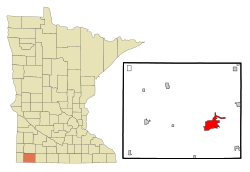Worthington, Minnesota
| Worthington, Minnesota | |
|---|---|
| City | |

Tenth Street in downtown Worthington in 2007
|
|
| Motto: You'll Come To Love Us | |
 Location of the city of Worthington within Nobles County in the state of Minnesota |
|
| Coordinates: 43°37′26″N 95°35′57″W / 43.62389°N 95.59917°W | |
| Country | United States |
| State | Minnesota |
| County | Nobles |
| Government | |
| • Type | Mayor - Council |
| • Mayor | Mike Kuhle |
| Area | |
| • Total | 8.74 sq mi (22.64 km2) |
| • Land | 7.34 sq mi (19.01 km2) |
| • Water | 1.40 sq mi (3.63 km2) |
| Elevation | 1,591 ft (485 m) |
| Population (2010) | |
| • Total | 12,764 |
| • Estimate (2015) | 13,090 |
| • Density | 1,739.0/sq mi (671.4/km2) |
| Time zone | Central (CST) (UTC-6) |
| • Summer (DST) | CDT (UTC-5) |
| ZIP code | 56187 |
| Area code(s) | 507 |
| FIPS code | 27-71734 |
| GNIS feature ID | 0654391 |
| Website | City Website |
Worthington is a city and county seat of Nobles County, Minnesota, United States. The population was 12,764 at the 2010 census.
The city's site was first settled in the 1870s as Okabena Station on a line of the Chicago, St. Paul, Minneapolis and Omaha Railway, later the Chicago and North Western Railway (now part of the Union Pacific Railroad) where steam engines would take on water from adjacent Lake Okabena. More people entered along with one A.P. Miller of Toledo, Ohio, under a firm called the National Colony Organization. Miller named the new city after his wife's maiden name.
The first European likely to have visited the Nobles County area of southwestern Minnesota was French explorer Joseph Nicollet. Nicollet mapped the area between the Mississippi and Missouri Rivers in the 1830s. He called the region “Sisseton Country” in honor of the Sisseton band of Dakota Indians then living there. It was a rolling sea of wide open prairie grass that extended as far as the eye could see. One small lake in Sisseton Country was given the name “Lake Okabena” on Nicollet’s map, “Okabena” being a Dakota word meaning “nesting place of the herons.”
The town of Worthington was founded by "Yankees" (immigrants from New England and upstate New York who were descended from the English Puritans who settled New England in the 1600s).
...
Wikipedia
